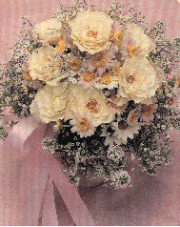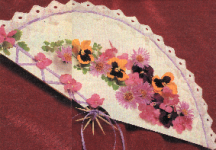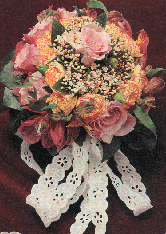
Home -
Foreword -
Georg Philipp -
Piano Business -
Lymington -
Trees -
Related Topics
Alphabetical Links
 |
THE LANGUAGE OF FLOWERS
Flower arranging today brings to mind a harmonious, decorative selection of flowers and foliage, with the plant material being of importance. But in Victorian times it was the embellishment itself that was the art; plants and flowers were used as ornaments, often in already over-dressed rooms.
The ever-expanding choice of plant material was at the heart of the changing style of the 19th and early 20th centuries. New breeds, new varieties, new colours and unusual hybrids became available to all gardeners - such plants were no longer exclusively for the very rich.
The popularity of the herbaceous garden offered a succession of fresh material until late autumn; but although Victorian markets could offer a wide choice of varieties (some of which might be difficult to find in the modern flower shop, such as mignonette, auricula, bluebells and orange blossom,) they would have been severely limited by the seasons. Victorians would be green with envy at the range of different flowers now available all year round.
 Posy vases, of all shapes and sizes, massed with flowers, were common everyday arrangements and would be placed among the clutter on ornamental tables. If the house had several reception rooms they would have been simply adorned with a profusion of pot plants, to which fresh flower arrangements would be added for special occasions. Visitors would carry posies and sometimes leave their floral bouquet with the lady of the house at their last port of call.
Posy vases, of all shapes and sizes, massed with flowers, were common everyday arrangements and would be placed among the clutter on ornamental tables. If the house had several reception rooms they would have been simply adorned with a profusion of pot plants, to which fresh flower arrangements would be added for special occasions. Visitors would carry posies and sometimes leave their floral bouquet with the lady of the house at their last port of call.
Inventiveness was a true Victorian attribute and can be applied particularly to their party-flower designs. By the mid-19th century flowers had become an important part of the extravagant and complicated plans for entertaining. No idea was too elaborate. Even middle-class families could look forward to a regular round of dances, dinners, musical evenings and entertainment at home or in the home of friends. In her book, God Bless Our Home - describing 19th century life in Canada, Una Abrahamson, quoting from The Home Manual of 1889, suggests "a novel and pretty entertainment for a summer evening can be given by setting aside an hour for a "Floral Conversation".
Bunches of flowers and foliage were arranged on a table from which the guests chose the required message. It adds that the plant material should be named, presumably to avoid embarrassing mistakes!
Floral adornments.
No well-dressed lady would have appeared at an evening function without fresh flowers worn on her dress and /or in her hair. In fact, most ladies arriving for a ball would be carrying flowers as well as wearing them. The true Victorian posy of concentric rings of small flowers around a central rose was extremely popular and many a keep-sake flower was pressed in a dance programme.
 Flowers also often adorned a ladyís fan. One type of floral fan, based on a palm leaf that had previously been covered with silver paper, was decorated with fresh, flat flower heads such as pansies, busy lizzies and primroses. Others were made from paper frames or pleated buckram (a stiffened linen material). A contemporary book on etiquette suggests that "Floral Fans are in good taste for guests to carry at weddings, full evening parties, balls and the opera."
Flowers also often adorned a ladyís fan. One type of floral fan, based on a palm leaf that had previously been covered with silver paper, was decorated with fresh, flat flower heads such as pansies, busy lizzies and primroses. Others were made from paper frames or pleated buckram (a stiffened linen material). A contemporary book on etiquette suggests that "Floral Fans are in good taste for guests to carry at weddings, full evening parties, balls and the opera."
The Victorians were also highly inventive with their wedding flowers. Mrs de Salis in her "Floral Decoration a la Mode", published in 1891, says that "Shoes are now often carried by bridesmaids, instead of posies; the shoes are made of satin, filled with flowers and decorated with ribbon or lace. A pale pink shoe with pink roses looks charming".
Victorian propriety dictated that wedding ceremonies were accorded due reverence and that all brides were seen to be modest. Their love of symbolism was much in evidence in the flower decorations in church. Lilies to represent purity, orange blossom for virginity and roses for incorruptibility were arranged with the same flowing greenery that would be used in abundance at the wedding breakfast.
The chaste modesty of the bride would have been reflected in her dress, her manner and her flowers. Lithographs of Queen Victoriaís wedding show her carrying a small frilled posy of mixed flowers, which was a favourite style until Edwardian elegance superceded Victorian convention.
 Camellias, white heather, carnations and ranunculus are still fashionable today, but the delicate sweet-smelling blossoms of the orange tree are sadly no longer readily available. Complimentary sprays of orange blossom would have been tucked into bridal bonnets or placed over the retaining bands of veils. Wax replicas of these attractive flowers continued to be used as accessories or as decoration on traditional wedding cakes well into the 20th century, until the ubiquitous plastic regrettably replaced the beautiful pearly wax.
Camellias, white heather, carnations and ranunculus are still fashionable today, but the delicate sweet-smelling blossoms of the orange tree are sadly no longer readily available. Complimentary sprays of orange blossom would have been tucked into bridal bonnets or placed over the retaining bands of veils. Wax replicas of these attractive flowers continued to be used as accessories or as decoration on traditional wedding cakes well into the 20th century, until the ubiquitous plastic regrettably replaced the beautiful pearly wax.
The language and lore of flowers
Individual blooms became associated with different meanings and fancies:
Alyssum meant "Worth beyond beauty".
Daisies came to have a variety of meanings, including "You have as many virtues as this flower has petals", and "Innocence". Before Victorian times, however, the ox-eye daisy was used as an emblem of deceit. Perhaps the daisyís alternative name is as accurate as anything; it was called "Measure of love."
Forget-me-not, when included in a mixed bunch of flowers that did not have a collective meaning, was used to say "Here is the key to my heart".
Geranium flowers brought the message "I miss you, so please comfort me".
Scented geranium leaves symbolised an "Unexpected meeting". They were much used to decorate posies which were carried when calling - perhaps in hope rather than expectation!
Ivy represented Constancy and Fidelity and would certainly have featured in great profusion at Victorian weddings.
Maidenhair fern, as the name suggests, was used to symbolise "Modesty".
Michaelmas daisies stood for an afterthought because they bloom late in the year; or, when given to a gentleman by a lady, "I wish things had been different".
Orchids were among the flowers most highly prized by Victorians as they were said to represent "longevity", although they were appreciated as much for their beauty as for their symbolism.
Pansies were represented by a number of charming nicknames which suggest a variety of meanings;
"Think of me",
"Call me to you",
"Jump up and kiss me",
"Kiss me at the garden gate",
"Tickle my fancy" and
"Heartís ease".
Roses, featured in dreams, were considered a sign of good fortune. An old custom was for a girl to pick a rosebud on Mid-summerís Day, wrap it tightly and keep it until Christmas Day. If she then wore the rose to church, the man she was destined to marry would take it from her.
Red roses symbolised eternal love to the Victorians, just as they have universally throughout history.
According to tradition in many countries, all roses began white, but were stained red by the blood of divinity.
In ancient Greece it was the blood of Adonis, who was wounded by a wild boar;
In Muslim countries it was the blood of Mohammed;
and according to Christian belief, it was the blood of Christ.
In Persia, legend states that a nightingale, overcome with the beauty of a white rose, clasped it so tightly to itís breast that the thorns pierced itís heart, thus staining the rose a deep blood red.
Among the many "love charms" associated with roses is one that requires a young girl to pick a red rose at midnight and tuck it into her waistband. Thus accoutred, she should knock at the door of the hen-house. If the hens cackle she will never marry, but if the cock answers, she will marry soon. (The writer adds, somewhat cynically, that the trick was to knock at the top of the door, because the cock invariably took the highest perch!)
White roses denoted truth, or keeping secrets. They were sacred to the Goddess of Love, Venus, whose "Amorous and stolen sports should never be revealed".
Rosemary was used at weddings, both in garlands and wreaths. Small sprigs were dropped into the wedding wine to ensure lasting happiness. Through the ages it has been the symbol of remembrance.
Woman and Home January 1991
back to top
The Language of Flowers